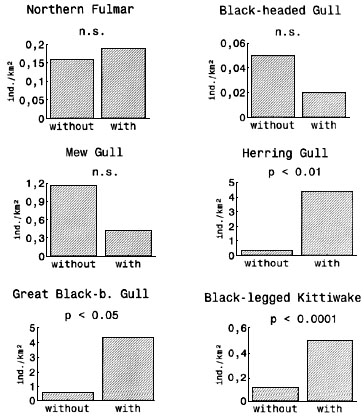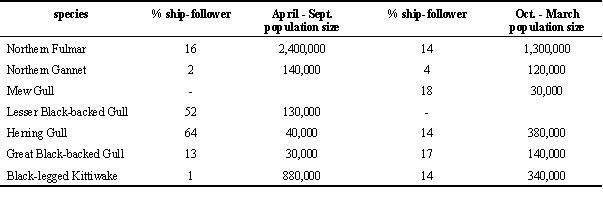
S12.4: The influence of fishing activities on the distribution and feeding ecology of seabirds at sea
Stefan Garthe
Institut für Meereskunde, Abteilung Meereszoologie, Düsternbrooker Weg 20, D-24105 Kiel, Germany, fax 49 431 597 3994, e-mail sgarthe@ifm.uni-kiel.de
Garthe S. 1999. The influence of fishing activities on the distribution and feeding ecology of seabirds at sea. In: Adams, N.J. & Slotow, R.H. (eds) Proc. 22 Int. Ornithol. Congr., Durban: 706-716. Johannesburg: BirdLife South Africa.Most fisheries produce discards and offal in considerable quantities and discharge them at sea where they are preyed upon by many seabird species. It is therefore likely that fishing vessels may influence both the distribution and the feeding ecology of such species. Case studies from the North Sea, the Benguela region and the seas off eastern Australia provide detailed examples of these effects. Although spatial scale is an important variable in the relationships between trawler and seabird distributions, three major classifications can be elected: some species are not affected at all by trawler distribution; some species are attracted by trawlers only locally, e.g. in certain hydrographic regions; some species are consistently attracted by trawlers. These variations in responses are reflected by the relative contributions of discards and offal to the species' diet, ranging from ignoring fishery waste to comprising major proportions of the diet. The different utilisation of this surplus food may influence breeding success, survival and population development which in turn could affect the composition of the seabird communities.
INTRODUCTION
The supply of surplus food from fishing activities, namely discards and offal, has strong effects on seabirds. Since fisheries and seabirds are both distributed over the most productive regions of the world, the phenomenon of birds attending fishing vessels is widespread (e.g. Eastern Australia: Wassenberg & Hill 1990; Blaber et al. 1995; Northeast Pacific: Wahl & Heinemann 1979; Falkland Islands: Thompson 1992). Scavenging seabirds can comprise nearly the whole seabird fauna of an area, e.g. 90% of all seabirds recorded in the southern Benguela region in winter (derived from Ryan & Moloney 1988), or only a very small proportion, as has been found for the winter seabird community of the Baltic Sea in Europe; because of the large numbers of over-wintering sea ducks, only 6% of the seabirds can be considered scavengers (derived from Durinck et al. 1994) although the sea hosts intense fisheries.
Recent studies have shown that the availability of discards and offal partly influences breeding parameters such as breeding phenology, reproductive output, foraging range, kleptoparasitism and predation, but also at-sea distribution, numbers of resting birds, diel activity and diet (e.g. Arcos & Oro 1996; Blaber et al. 1995; Castilla & Pérez 1995; Garthe & Hüppop 1996, 1998a; Noordhuis & Spaans 1992; Oro 1995; Oro et al. 1996; Regehr & Montevecchi 1997; Tasker et al. 1987). Concluding from all these studies, there is evidence that some seabird species at least partly depend on fishery waste. The severe effects of discard availability on breeding Larus-gulls are reviewed by Oro (this volume). Less evidence but also strong effects are visible for tropical seabirds of the northern Great Barrier Reef, Australia (Blaber et al. 1995). Although discards have hardly affected breeding cycles or nesting periodicity, juvenile birds may have become conditioned to feeding on discards and may experience reduced mortality rates. Discard components may comprise up to 70% of the diet of the Crested Tern (Sterna bergii), but (much) less in other species (Blaber et al. 1995).
Hudson & Furness (1988) were the first to investigate in detail how intense seabirds feed upon discards in the North Sea. Meanwhile, several studies on board commercial and fishery research vessels have enabled us to assess discards and offal consumption by seabirds on a large scale in this sea. Trawl fisheries, mainly for gadoids and flatfish, complemented by smaller or less wasting fisheries, discharge on average some 60,000 t of offal, 260,000 t of roundfish, 300,000 t of flatfish, 15,000 t of elasmobranchs and 150,000 t of benthic invertebrates per year representing 4% of the total biomass of fish and 22% of the total landings (Garthe et al. 1996). From discard experiments it was estimated that seabirds consumed annually about 55,000 t of offal, 206,000 t of roundfish, 38,000 t of flatfish, 2,000 t of elasmobranchs and 9,000 t of benthic invertebrates (Garthe et al. 1996). Although new methodological studies revealed that this values are apparently overestimated (Garthe & Hüppop 1998b), the consumption is still in the magnitude of 200,000 t (Garthe unpubl. data).
Since fishing activities occur all over the North Sea and at all seasons (Camphuysen et al. 1995), there are no areas within this sea where seabirds may not be affected by fishing activities. However, from counts of seabirds attending fishing vessels it has been found that certain species are regular visitors at trawlers while others are not (e.g. Furness et al. 1992; Garthe & Hüppop 1994; Walter & Becker 1997). Furthermore, these scavenging communities vary as a function of parameters such as available nearby nesting habitats, latitude and hydrographic regime. It is therefore reviewed in this paper to what extent trawling activity influences the distribution and diet of seabirds in the North Sea.
MATERIAL AND METHODS
During a North Sea wide study on discard utilisation by seabirds (Camphuysen et al. 1995), seabird numbers at sea - independently of fishing vessels - and seabird numbers behind commercial fishing vessels were estimated separately. From these two figures, the proportion of ship-followers were calculated for each seabird species and each of the four seasons (being equivalent to the four quarters of the year). Mean values were subsequently obtained for ‘summer’ (second and third quarter) and ‘winter’ (first and fourth quarter).
Sound analyses on the influence of trawler abundance and/or distribution on seabird density and/or distribution suffer from the fact that hydrography and colony location (during the breeding season) are also major influents. To circumvent these problems, only the non-breeding period is considered in this paper, assuming that the birds are distributed more independently from a central place. A large-scale approach is followed using the data obtained during a North Sea wide study on discard utilisation by seabirds (Camphuysen et al. 1995). Within this study, the North Sea was divided into six subregions and four seasons. Data on seabird densities per species, season and subregion were derived from Camphuysen et al. (1995). Data on trawler densities per season and subregion were taken from Camphuysen et al. (1995), data on the availability of total fishery waste, roundfish discards and offal per subregion originated from Garthe et al. (1996). Seabird densities (dependent variable) were correlated with the different parameters of trawling activity (independent variable) by Spearman rank correlation, using the six subregions as cases.
A smaller-scale approach was followed during a dedicated cruise on seabird-hydrography-fisheries-relationships in the southeastern North Sea from 25 October to 2 November 1993. Bird densities were calculated over the counting intervals which amounted to areas of 2.1 to 4.9 km² located around the 156 hydrographic stations. Fishing vessel abundance was also assessed at the same time as bird observations by recording the exact distance of vessels within a radius of 3 km (checked by radar) around the observation platform. All vessels actively fishing (i.e. excluding steaming and resting ships) were summarised. In order to account for the different distances to the coast and the different influence of freshwater run-off, analyses were done separately for all stations less than 50 km off the nearest coast and for all stations more than 50 km off the nearest coast. Seabird density values were compared between counting intervals with and without trawlers.
In order to assess the relative importance of fishery waste to the nutrition of seabirds, it is sensible to estimate the proportion of discards and offal in the diet of seabirds. Most studies fail, however, to evaluate accurately diet composition by prey mass or energy content for a variety of reasons (see Duffy & Jackson 1986 for a review). This holds particularly true for species preying upon a wide range of prey taxa and trophic levels such as gulls and fulmars. Reviewing the available diet studies, the ‘ICES Working Group on Seabird Ecology’ came up with rather crude average proportions of discards and offal in the diet of the most important seabird species in the North Sea which are compiled in this paper. Furthermore, the differences between years, locations and breeding stages are presented for a variety of diet studies of the Herring Gull (see Table 3 for scientific bird names) in the North Sea.
Seabird communities were divided into scavengers and non-scavenger. Although even typical non-scavengers have been noticed a few times to follow fishing vessels, a division into these two categories seems appropriate. Breeding bird numbers of Britain and Ireland were taken from Lloyd et al. (1991). Numbers of seabirds in the North Sea were derived from Skov et al. (1995). Following Garthe (1993) and Camphuysen et al. (1995), all procellariiforms, gannets, skuas and gulls were considered scavengers, whereas cormorants, terns and auks were considered non-scavengers.
RESULTS
At-sea distribution of seabirds in relation to fishing vessels
During the summer half of year, Lesser Black-backed Gulls and Herring Gulls were following fishing vessels particularly often, compared to their total number at sea (Table 1). Northern Gannets and Black-legged Kittiwakes were, in contrast, present at trawlers only in very minor proportions. In the winter half of year, none of the species visited trawlers to a particular high degree; again, Northern Gannets were seen relatively rare (Table 1).
On a large scale in the North Sea, trawler density was only significantly correlated with Northern Fulmars density in winter but with none of the other five species (Table 2). The three Larus-gulls were partly correlated with the availability of discards and offal (Table 2).
On a much smaller scale, the presence of trawlers significantly affected the density of some seabird species in the southeastern North Sea in autumn, both in the inshore (less than 50 km off the coast) and in the offshore (more than 50 km off the coast) areas. Inshore, Herring Gulls, Great Black-backed Gulls and Black-legged Kittiwakes were significantly more numerous when trawlers were present within a radius of 3 km around the observation platform (Fig. 1). Looking at the same seabird species offshore (not shown in figure), only Great Black-backed Gulls were significantly more numerous (0.32 ind./km², n = 5 counting intervals) during the presence of trawlers (0.11 ind./km², n = 22).
Contribution of discards and offal to the diet of seabirds
Whereas auks do not feed upon discards and offal, many other seabird species do so. Northern Fulmars, Great Skuas, Lesser and Great Black-backed Gulls as well as Black-legged Kittiwakes (in winter only) take approximately half of their diet as fishery waste (Table 3). Several studies on the diet of Herring Gulls, in particular on breeding birds in the southern North Sea, clearly demonstrate the variability depending on location, season, year and probably also method of analysis.
Seabird communities
Both in summer and winter, scavengers dominate the North Sea at-sea avifauna by individuals (66% and 53%, respectively) as well as by biomass (Garthe et al. 1996). A similar pattern arises for the composition of seabirds breeding in Britain and Ireland. Compared between 1969-70 and 1985-87, however, the percentage of scavengers has decreased from 64% to 58% (although the absolute numbers have increased slightly), mainly due to a strong increase in the non-scavenging Common Guillemots (Lloyd et al. 1991).
DISCUSSION
North Sea fisheries influence both the distribution and the feeding ecology of some but not all seabird species. Spatial scale is an important variable in the relationships between trawler and seabird distributions so that effects of trawler distribution and abundance on seabird distribution and abundance can easily be overseen if choosing the wrong scale. Two scales have been applied in this paper revealing tendencies to what extent seabird distribution might be influenced by trawling activity. From this but also from a previous analysis by Garthe (1997) it appears that at least gull densities are elevated locally near trawler (fleets), hence trawler distribution influencing seabird distribution on a small scale rather than on larger scales. Generally, three major classifications of seabird reactions to trawlers can be elected: (1) Some species are not affected at all by trawler distribution; all North Sea auk species do belong to this category although single individuals have been noticed to follow trawlers (e.g. Camphuysen et al. 1995); (2) some species are attracted by trawlers only locally, e.g. in certain hydrographic regions; the Northern Fulmar is the best example of this category in the North Sea: although this species is a common ship-follower in the North Sea, hydrography predicts Northern Fulmar distribution better than fisheries, on a large scale (Camphuysen & Garthe 1997) as well as on the much smaller scale (Garthe 1996); (3) some species are consistently attracted by trawlers; the large Larus-gulls are the most obvious representatives of this category. A similar classification was suggested by Ryan & Moloney (1988) for the southern Benguela region.
Species' variations in responses to trawlers are reflected by the relative contributions of discards and offal to their diet, ranging from ignoring fishery waste to comprising major proportions of the diet. Again, large gulls (as well as the Great Skua) are utilising discards most often as derived from dietary analyses in breeding colonies. There are, however, differences between the breeding season and the winter. In Black-legged Kittiwakes, e.g., discards are consumed much more numerous in winter but are nearly absent in the diet during the breeding period, reflected also in a higher percentage of individuals following vessels in winter (Table 1). The differences between locations but also between seasons and years are very obvious taking the Herring Gull as probably the best-studied species. Generally, Herring Gulls from the southern North Sea utilise discards and offal only to a very minor percentage but feed upon molluscs and crustaceans from the tidal flats instead (cf. sources listed in Table 4). Locally, however, proportions of discards in the diet almost reach values found in a study in the Firth of Forth (Furness et al. 1992). The usual composition of the diet on the one hand and, in contrast, the importance of trawlers as determinants of their distribution (Fig. 1; Garthe 1997) and the high degree of ship-followers (Table 1; Garthe 1997) on the other hand suggest that most Herring Gulls in the southeastern North Sea are feeding in the intertidal zone but those that forage at sea are severely affected by fishing activities.
The importance of discards as seabird food in the North Sea becomes also obvious when considering that more than the half of all birds, up to 6 million individuals (Camphuysen et al. 1995), regularly feed upon this surplus food. Although the species utilise fishery waste to different extents, the division of the seabirds into scavengers and non-scavengers points to an essential characteristics of the seabird communities. It has been debated recently whether seabird population growth is (partially) the result of fishing activities and whether fishing activities have already altered or will alter the composition of the seabird avifauna (e.g. Dunnet et al. 1990; Hüppop et al. 1994; Garthe et al. 1996). The decrease in the percentage of scavengers in the British breeding seabird populations suggests that such effects have, if so, already occurred a few decades ago. To really understand these relationships one needs to focus on the changes of all north-west European seabird population sizes in relation to fisheries. The high degree of the utilisation of discards by large Larus gulls and their obvious dependence on this type of food (see Introduction), suggest that reductions in fishery waste availability will (again) alter the composition of the seabird community in the North Sea and will probably also reduce the absolute numbers of seabirds (see Furness 1992 and Garthe et al. 1996 for further discussion).
ACKNOWLEDGEMENTS
I am indebted to Kees Camphuysen, Ommo Hüppop and many other colleagues for help and co-operation during fieldwork and for stimulating discussions.
REFERENCES
Arcos, J.M. & Oro, D. 1996. Changes in foraging range of Audouin's Gulls Larus audouinii in relation to a trawler moratorium in the western Mediterranean. Colonial Waterbirds 19: 128-131.
Blaber, S.J.M., Milton, D.A., Smith, G.C. & Farmer, M.J. 1995. Trawl discards in the diets of tropical seabirds of the northern Great Barrier Reef, Australia. Marine Ecology Progress Series 127: 1-13.
Blaber, S.J.M. & Wassenberg, T.J. 1989. Feeding ecology of the piscivorous birds Phalacrocorax varius, P. melanoleucos and Sterna bergii in Moreton Bay, Australia: diets and dependence on trawler discards. Marine Biology 101: 1-10.
Camphuysen, C.J., Calvo, B., Durinck, J., Ensor, K., Follestad, A., Furness, R.W., Garthe, S., Leaper, G., Skov, H., Tasker, M.L. & Winter, C.J.N. 1995. Consumption of discards by seabirds in the North Sea. Final report EC DG XIV research contract BIOECO/93/10. NIOZ-Report 1995-5, Netherlands Institute for Sea Research, Texel.
Camphuysen, C.J. & Garthe, S. 1997. An evaluation of the distribution and scavenging habits of Northern Fulmars Fulmarus glacialis in the North Sea. ICES Journal of Marine Science 54: 654-683.
Castilla, A.M. & Pérez, J.J. 1995. Relationships between fishery activities and presence of the Audouin's Gull (Larus audouinii) in the Columbretes Islands. Colonial Waterbirds 18: 108-112.
Dernedde, T. 1993. Vergleichende Untersuchungen zur Nahrungszusammensetzung von Silbermöwe (Larus argentatus), Sturmmöwe (Larus canus) und Lachmöwe (Larus ridibundus) im Königshafen/Sylt. Corax 15: 222-240.
Duffy, D.C. & Jackson, S. 1986. Diet studies of seabirds: a review of methods. Colonial Waterbirds 9: 1-17.
Dunnet, G.M., Furness, R.W., Tasker, M.L. & Becker, P.H. 1990. Seabird ecology in the North Sea. Netherlands Journal of Sea Research 26: 387-425.
Durinck, J., Skov, H., Jensen, F.P. & Pihl, S. 1994. Important marine areas for wintering birds in the Baltic Sea. EU DG XI research contract no. 2242/90-09-01. Ornis Consult Report, København.
Furness, R.W. 1992. Implications of changes in net mesh size, fishing effort and minimum landing size regulations in the North Sea for seabird populations. JNCC Report 133, Joint Nature Conservation Committee, Aberdeen.
Furness, R.W., Ensor, K. & Hudson, A.V. 1992. The use of fishery waste by gull populations around the British Isles. Ardea 80: 105-113.
Garthe, S. 1993. Quantifizierung von Abfall und Beifang der Fischerei in der südöstlichen Nordsee und deren Nutzung durch Seevögel. Hamburger avifaunistische Beiträge 25: 125-237.
Garthe, S. 1996. Distribution and abundance of North Sea seabirds and their feeding ecology in relation to fisheries and hydrography. PhD Thesis, University of Kiel, Germany.
Garthe, S. 1997. Influence of hydrography, fishing activity, and colony location on summer seabird distribution in the south-eastern North Sea. ICES Journal of Marine Science 54: 566-577.
Garthe, S., Camphuysen, C.J. & Furness, R.W. 1996. Amounts of discards by commercial fisheries and their significance as food for seabirds in the North Sea. Marine Ecology Progress Series 136: 1-11.
Garthe, S. & Hüppop, O. 1994. Distribution of ship-following seabirds and their utilisation of discards in the North Sea in summer. Marine Ecology Progress Series 106: 1-9.
Garthe, S. & Hüppop, O. 1996. Nocturnal scavenging by gulls in the southern North Sea. Colonial Waterbirds 19: 232-241.
Garthe, S. & Hüppop, O. 1998a. Foraging success, kleptoparasitism and feeding techniques in scavenging seabirds; does crime pay? Helgoländer Meeresuntersuchungen 52: in press.
Garthe, S. & Hüppop, O. 1998b. Possible bias in experiments evaluating the consumption of discards by seabirds in the North Sea. Marine Biology: in press.
Gloe, P. 1986. Zum Nahrungsspektrum einer jungen Silbermöwe (Larus argentatus)-Ansiedlung an der schleswig-holsteinischen Westküste. Seevögel 7: 32-33.
Hudson, A.V. & Furness, R.W. 1988. Utilisation of discarded fish by scavenging seabirds behind white fish trawlers in Shetland. Journal of Zoology, London 215: 151-166.
Hüppop, O., Garthe, S., Hartwig, E. & Walter, U. 1994. Fischerei und Schiffsverkehr: Vorteil oder Problem für See- und Küstenvögel?. In: Lozán, J.L., Rachor, E., Reise K., von Westernhagen, H. & Lenz, W. (eds): Warnsignale aus dem Wattenmeer. Wissenschaftliche Fakten. Blackwell Wissenschafts-Verlag, Berlin: 278-285.
ICES (1997): Report of the Working Group on Seabird Ecology. ICES CM 1997/L:3.
Lloyd, C., Tasker, M.L. & Partridge, K. 1991. The status of seabirds in Britain and Ireland. Poyser, London.
Noordhuis, R. & Spaans, A.L. 1992. Interspecific competition for food between Herring Larus argentatus and Lesser Black-backed Gulls L. fuscus in the Dutch Wadden Sea area. Ardea 80: 115-132.
Oro, D. 1995. The influence of commercial fisheries in daily activity of Audouin's Gull Larus audouinii in the Ebro Delta, NE Spain. Ornis Fennica 72: 154-158.
Oro, D., Jover, L. & Ruiz, X. 1996. Influence of trawling activity on the breeding ecology of a threatened seabird, Audouin's Gull Larus audouinii. Marine Ecology Progress Series 139: 19-29.
Prüter, J. 1988. Weitere Untersuchungen zur Ernährung von Mantel- (Larus marinus) und Silbermöwe (Larus argentatus) bei Helgoland im Winterhalbjahr. Seevögel 9, Sonderband: 79-91.
Prüter, J., Sahmow, A. & Vauk-Hentzelt, E. 1988. Untersuchungen zur Ernährung der Silbermöwe (Larus argentatus) auf der Insel Scharhörn (Elbmündung) während der Brutzeit. Seevögel 9: 56-58.
Regehr, H.M. & Montevecchi, W.A. 1997. Interactive effects of food shortage and predation on breeding failure of Black-legged Kittiwakes: indirect effects of fisheries activities and implications for indicator species. Marine Ecology Progress Series 155: 249-260.
Ryan, P.G. & Moloney, C.L. 1988. Effect of trawling on bird and seal distributions in the southern Benguela region. Marine Ecology Progress Series 45: 1-11.
Skov, H., Durinck, J., Leopold, M.F. & Tasker, M.L. 1995. Important bird areas for seabirds in the North Sea including the Channel and the Kattegat. BirdLife International, Cambridge.
Tasker, M.L. & Furness, R.W. 1996. Estimation of food consumption by seabirds in the North Sea. ICES Cooperative Research Report 216: 6-42.
Tasker, M.L., Webb, A., Hall, A.J., Pienkowski, M.W. & Langslow, D.R. 1987. Seabirds in the North Sea. Final report of phase 2 of the Nature Conservancy Council Seabirds at Sea Project November 1983 - October 1986. Nature Conservancy Council, Peterborough.
Thompson, K.R. 1992. Quantitative analysis of the use of discards from squid trawlers by Black-browed Albatrosses Diomedea melanophris in the vicinity of the Falkland Islands. Ibis 134: 11-21.
Wahl, T.R. & Heinemann, D. 1979. Seabirds and fishing vessels: co-occurrence and attraction. Condor 81: 390-396.
Walter, U., Becker, P.H. 1997. Occurrence and consumption of seabirds scavenging on shrimp trawler discards in the Wadden Sea. ICES Journal of Marine Science 54: 684-694.
Wassenberg, T.J. & Hill, B.J. 1990. Partitioning of material discarded from prawn trawlers in Moreton Bay. Australian Journal of Marine and Freshwater Research 41: 27-36.
Wilkens, S., Exo, K.-M. 1998. Brutbestand und Dichteabhängigkeit des Bruterfolges der Silbermöwe (Larus argentatus) auf Mellum. Journal für Ornithologie 139: 21-36.
Table 1. Proportions of seabirds as ship-followers in the North Sea during the two halves of the year. Data is taken from Camphuysen et al. (1995).

Table 2. Relationships between (a) seabird densities at sea and (b) trawler abundance and fishery waste availability, respectively, in six subregions of the North Sea. Spearman rank correlation coefficients are given, those underlined are significant (p < 0.05).
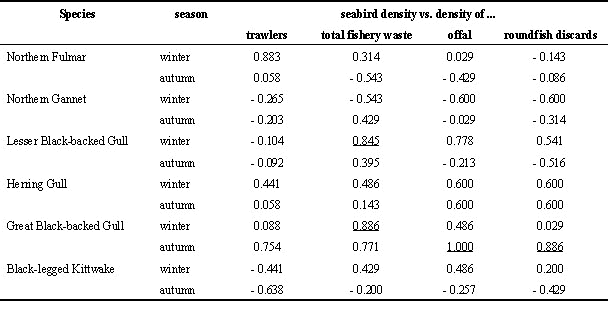
Table 3. Proportion (in %) of fishery waste in the diet of seabirds in the North Sea (from food consumption model in Tasker & Furness 1996, completed by ICES 1997).
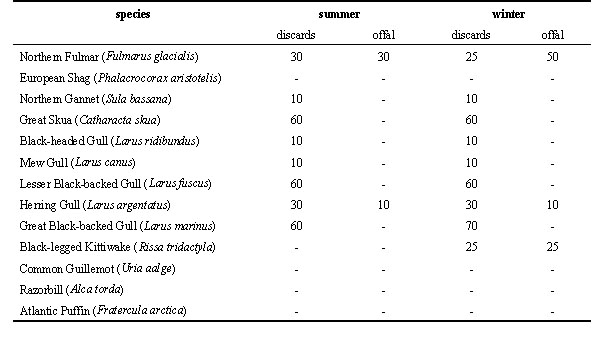
Table 4. Variability of the proportion of discards in the diet of (adult) Herring Gulls at the North Sea coasts in the 1980s and 1990s. Germany/The Netherlands: Occurrence of discard items in % of all samples, Scotland: Occurrence of discard items in % of all samples only when discards were the predominating or sole prey.
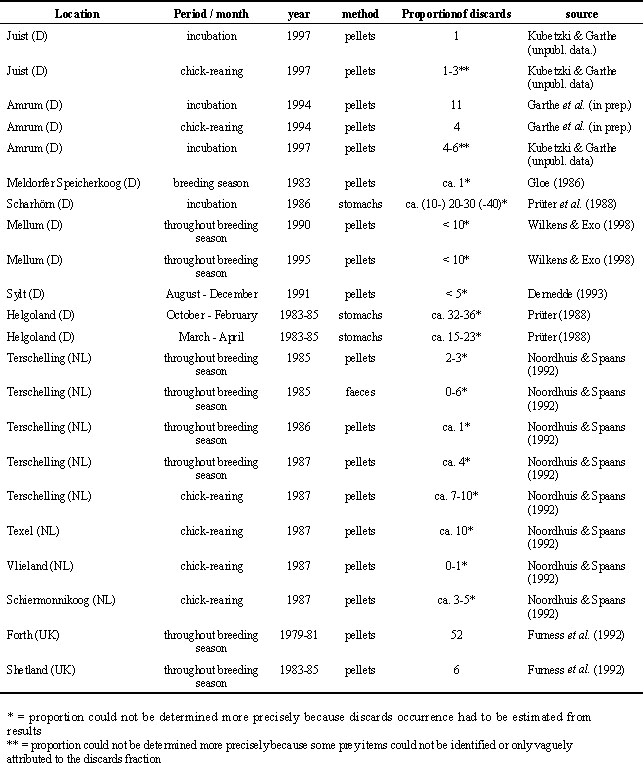
Fig. 1. Densities of six seabird species in the inshore German Bight (< 50 km off the coast) in relation to trawler abundance. The columns give the means of the respective counting intervals with (n = 18 counting intervals) and without (n = 111) trawlers within a radius of 3 km around the observation platform. Differences in seabird density were tested by the Mann-Whitney-U-test.
